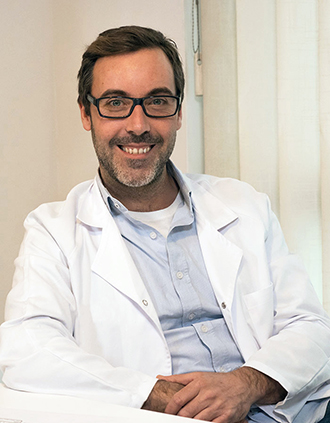 Danielle Larson, MD, Northwestern University Feinberg School of Medicine
Danielle Larson, MD, Northwestern University Feinberg School of Medicine
TeleHD: Feasibility, validity, and value of telemedicine for motor and non-motor assessments in patients with Huntington’s disease
Telemedicine is the use of video conferencing for meetings between patients and medical care professionals. This technology is being used more frequently for clinic visits and for research purposes. One main advantage of “televisits” is that they decrease the time and travel burden for patients, and allow patients to see specialists that practice far away. We are conducting a study on the use of telemedicine for individuals with Huntington’s disease (HD). We believe that televisits can be used to assess the motor and non-motor symptoms of HD as effectively as in-person clinic visits. We also believe that individuals with HD and their families will prefer to have some visits with their neurologist done remotely, as a televisit can save time, and decrease travel-related cost and stress. Our study will aim to confirm these beliefs by evaluating 40 individuals with HD who receive care at Northwestern University’s HDSA Center of Excellence. Each individual will complete two regular in-person clinic visits and two televisits. The in-person visits and the televisits will be compared to determine if HD symptoms are assessed similarly and accurately. Participants and their caregivers will complete a survey on their satisfaction with televisits and their preference for in-person or televisits, and will indicate if televisits decreased their time and cost burden. If our study shows that televisits can be effective for assessing HD symptoms, and that HD individuals and their families are satisfied by televisits, this will inform the Neurology community that televisits can and should be done for our patients with HD to improve their clinical care and the HD research field.
 Osama Al Dalahmah, MD, PhD, Columbia University
Osama Al Dalahmah, MD, PhD, Columbia University
The Transcriptional Landscape of Huntington Disease; Exploring the Neuroprotective Potential of Astrocytes at The Single Cell Level
Huntington’s disease (HD) is caused by a genetic mutation in the huntingtin (HTT) gene. The mutation is present in all brain cells, including neurons and supportive cells called astrocytes. Astrocytes are the major non-neuronal cells in the brain and maintain a healthy environment around neurons. In HD, astrocytes may become dysfunctional, contributing to the death of neurons. We hypothesize that astrocytes have two roles: they can either have protective effects on neurons, or become dysfunctional and lose their protective effects. We will test whether there are more of these “helpful” astrocytes in early HD, and whether there are more of the “damaging” astrocytes in more advanced stages of HD. To distinguish between the helpful and damaging cells, we need to examine which genetic RNA messages are found in single astrocytes in the human brain. We are using a cutting-edge technique for the first time in human HD brain tissue that allows us to isolate the cell nuclei, where the genetic information is stored. We then take RNA from individual nuclei and sequence it, and this knowledge allows us to understand the biological processes that underlie protective versus destructive astrocytes. By investigating how astrocytes in the HD brain are changed during the course of the disease, we will be better able to develop targeted therapeutic strategies for overcoming and possibly reversing these deleterious changes.
 Vilija Lomeikaite, PhD candidate, University of Glasgow
Vilija Lomeikaite, PhD candidate, University of Glasgow
Improving methods to accurately quantify somatic mosaicism in clinical samples from HD patients
Huntington’s disease (HD) is an inherited genetic disorder caused by an unstable DNA region. The larger this region is inherited by an individual, the earlier the disease symptoms start. This unstable DNA expands over the lifetime of an HD patient in most of the cells of the body. The fastest expansions with the largest expanded DNA regions are found in the brain, which likely explains the pattern of clinical and behavioral signs in HD patients. Research by our and other groups shows that the speed at which this unstable DNA region expands differs between patients, with higher expansion speed in some, and slower speed in others. It appears that when this unstable DNA expands less rapidly, the disease progression in HD patients is also slower. Due to limitations in current methods that we use to measure such expansions, we cannot yet fully understand why or how these DNA regions expand at different speeds. We propose here several novel improvements to the current methods that would enable us to confidently detect the number of expansions and potential contractions in hundreds of HD patients which in turn would facilitate further research towards better understanding of the expansion process. This would not only improve our fundamental understanding of HD, but would also enable new therapeutics development for drugs that aim to reduce the speed or completely stop DNA expansions.
Ricardo Mouro-Pinto, PhD, Massachusetts General Hospital/Harvard Medical School
Development of CAG Contraction-based Therapeutics for Huntington’s Disease
Huntington’s Disease (HD) is a devastating neurodegenerative disorder for which there is no cure or significant disease-modifying treatment. It is caused by a rare genetic mutation – an expanded CAG repeat – that results in the production of a toxic form of huntingtin protein. In general, the longer the CAG repeat, the earlier in life the patient will develop HD symptoms. In addition to being expanded in HD patients, this repeat has a strong tendency for further expanding, not only in transmissions from parent to child, but also throughout the life of the patient, particularly in organs primarily affected in HD. This raises the hypothesis that the CAG expansion process can accelerate the onset and progression of the disease in HD patients. To date, we have already learned that genes involved in maintaining the integrity of our genomes throughout the life of a cell (DNA repair genes) are involved in the CAG expansion mechanism. In addition, in a recent study that looked at ~9,000 HD patients, we identified various DNA repair genes as likely modifiers of HD age of onset, further echoing the potential therapeutic impact of targeting these genes. In recent studies using HD mice, we found a DNA repair complex that seems capable of contracting the HD CAG repeat. We will now carry out a set of experiments aimed at validating this ability in cells obtained from HD patients, as well as investigating the potential toxicity associated with targeting this gene. These studies will hopefully spearhead the development of therapeutics aimed at contracting the CAG repeat in HD patients.

Saul Martinez-Horta, MsC, Sant Pau Hospital, Barcelona
Neurobiological mechanisms subserving the differential expression and rate of progression of cognitive impairment in Huntington’s disease
Many years of research have contributed to a better understanding of the great complexity of Huntington’s disease (HD) and the multitude of brain regions that are affected. Beyond the primary genetic cause (CAG repeat expansion), multiple additional mechanisms may contribute to symptom presentation and progression. Cognitive impairments (difficulties with thinking and planning) are an essential feature of HD, but there is vast variability in the severity and rate of progression of these symptoms that cannot be solely explained by differences in CAG repeat length. Current efforts are directed at lowering the amount of the toxic protein that leads to HD. To optimize therapeutic strategies and to understand differences in the pattern of patient responses to future gene-silencing therapies, it will be necessary to investigate other mechanisms that may contribute to the clinical expression of HD. To this end, we want to better understand the cognitive profile of HD and how environmental and biological mechanisms contribute to differences in the deterioration of thinking. To do that, we will assess the cognitive profile of symptomatic patients and will obtain “biomarkers” in the plasma and cerebrospinal fluid that are known to be associated with neuronal damage and neurodegeneration. We will specifically look at brain structure and function in patients with dissimilar cognitive phenotypes. We will also explore the influence of environmental variables, genetic differences, and certain types of brain pathology on patients’ ability to think and function in daily life.


